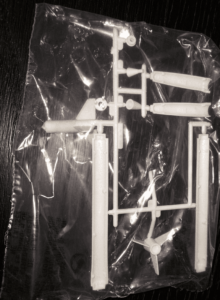
Folks, the subject line says it all. When I am assembling a plastic model kit, should I glue the parts together, and then paint the parts? Or (as the instructions seem to suggest) should I paint the parts first, and then glue them together?
As a bit of background, I acknowledge that this blog article is most likely to engage readers of a certain age. The model being assembled is made of injection-molded polystyrene, and was made by a company called Revell. The company still exists, I was surprised to learn, but the kit that is shown above is one that Revell does not make any more and it was very hard to find (I found it on eBay).
The parts are glued together using what I once called “airplane glue”. It may be recalled by readers of a certain age that the active ingredient in airplane glue is toluene (Wikipedia article). The important thing about toluene is that it penetrates slightly into polystyrene, softens it, and permits two softened polystyrene parts, when pressed together, to form a continuous (eutectic) bond. This is a room-temperature welding of two physical parts.
At which point I circle back around to my question.
When I am assembling one of these polystyrene model kits, should I glue the parts together, and then paint the parts? Or (as the instructions seem to suggest) should I paint the parts first, and then glue them together? If you have a view about this, please post a comment below.
And extra credit if any reader is able to say what the thing is that this kit models? Perhaps some reader, drawing upon knowledge from aerospace in the 1950s, can say what one ends up with if one assembles this model. If so, please post a comment below.

Test painting some dried glue to see if it readily takes up the paint… and also see if the glue is truly colorless. The results will likely indicate which to do first.
When I used to make plastic ‘Airfix’ model planes, I always painted first and then glued. However, when making a wooden model of a boat fairly recently it had to be assembled (glued) first before the boat was painted/varnished.
Looks like a model rocket.
Made a lot of planes and ships in the 50s and 60s, just never painted them.
But depending on size of the parts, probably better to paint and then glue (in a well-ventilated area).
True enough. Yes, a model rocket. But which rocket?
Suspect a Redstone rocket–used for the Mercury launches.
(don’t know if Revell made the V-2–too close to WW2).
Guessing: one of the earlier Aerobees. Aerobee Hi or Aerobee 150.
Neil wins! The rocket is an Aerobee-Hi (Wikipedia article).
I agree with Ben two posts above. I see the Mercury capsule, but had to look up what carried it.
I’d say glue then paint. But after painting, be sure to clean up with carbon tetrachloride like we did back in the early 60s. It smelled so good.
Always glue first. Doubly so if the model being assembled requires the glue to stay assembled. It’s easier to understand how the shadows should fall when you can see the fully assembled model, and easier to see the actual model than visualizing it. Minimize chances of mistakes.
Unless you’re a super genius at modeling, in which case you do what you want.
I don’t have any particular insight on the glue first or paint first issue — I’ve done it badly both ways. But Revell apparently still exists: http://www.revell.com . It’s been acquired and merged a few times, but still sells models.
Don’s right. There is a present-day company by that name. I have corrected the article.
If the glue used is a solvent, wouldn’t paint interfere if it were applied to the joining surface?
Yes, it does, so requires scraping the glue off any mating surfaces (similar to having to remove chrome plating from surfaces to be joined).
Anyone know if Aurora or Monogram are still around as well?
Monogram merged with Revell, so whatever kits are still in production are offered under Revell’s name.
Aurora is long gone, but many of their molds have been reissued under Polar Lights (an obvious reference to the Aurora name), Moebius, or Round 2.
Paint parts that will be inaccessible when assembled before assembly, paint parts that are going to require a seam to be filled & sanded after assembly after assembling, filling, sanding.